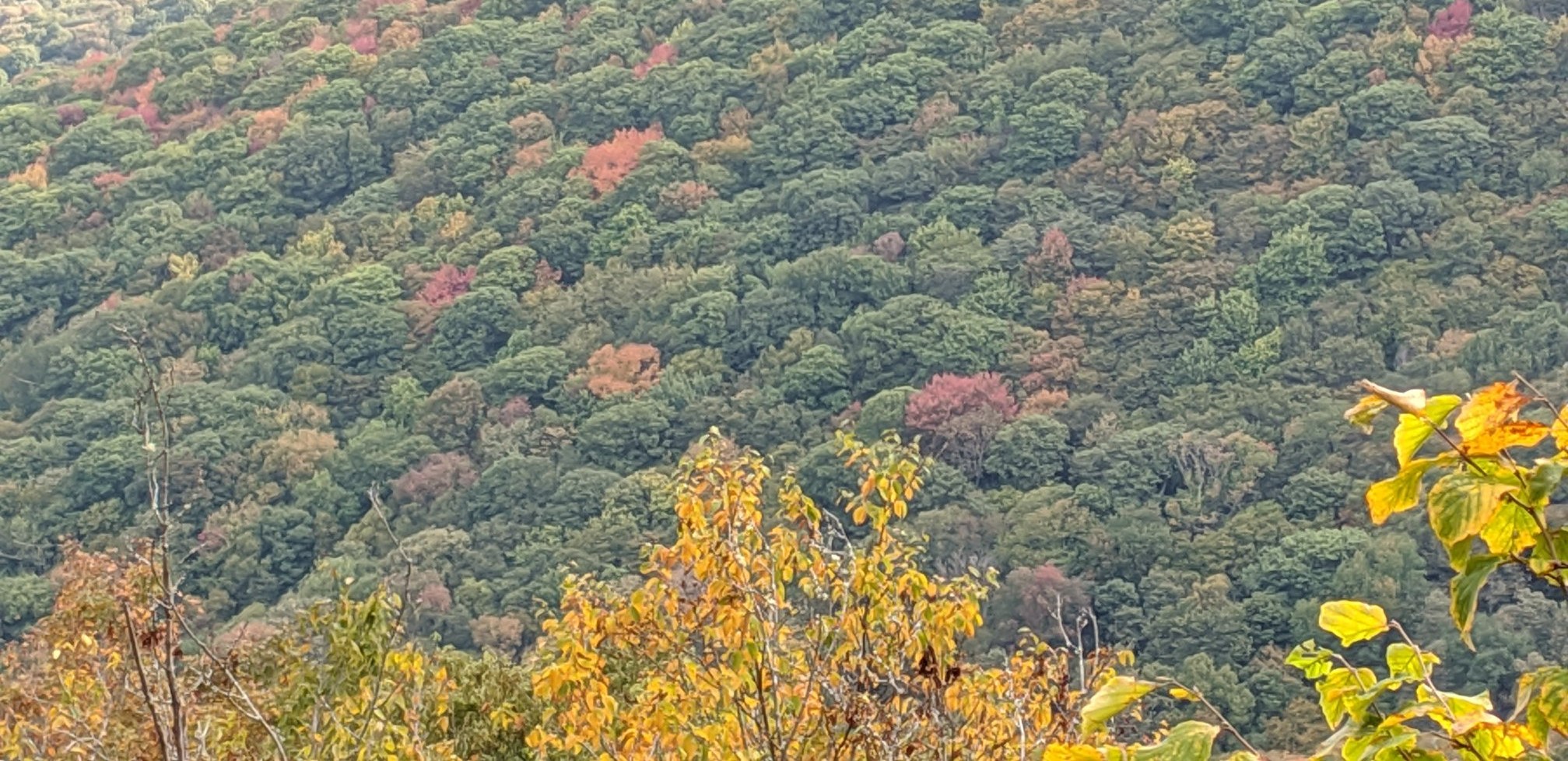
I went to Elk Knob State Park this morning to check out the colors there. Because this park rises up to 5,520’ elevation, there can be dramatic differences in the degree of fall color display since elevation exerts such a strong influence on the timing of peak color. I was surprised to see substantial color development beginning this weekend – isolated maples were showing up against a mostly green background, along with birches and beech and tulip poplars. We are definitely in the beginning stages of fall color development. And we’re on time, something I attribute to the cool mornings we’ve been having, even though our afternoons are unusually warm.
Witch’s Hobble (Viburnum lantanoides) is in full color development, at about the 1 mile mark on the trail. See the picture album I will put up after this posting for pictures of this and other species from my hike today. This species has large leaves that turn orange then purple, in splotches on the leaves, before becoming entirely dark purple. It is one of my favorite fall leaf color plants.
One of the most common herbs is Filmy Angelica (Angelica triquinata), a member of the parsnip family. This species is common along the lower 2/3 of the trail and at this time of year is beginning to senesce (meaning the leaves are dying off for the winter). It does so by first losing the chlorophyll in the leaf blade, but retaining it in the veins, giving it a distinctive pale color against the other green plants. I suspect the veins remain green longer than the blade so the plant can continue to withdraw nutrients from its leaves, and sending them to its underground rhizome, where they can be remobilized next year when the plant sends up new shoots. That saves the plant some energy and enables it to get a head start in the spring.
At about the 1.5 mile mark you will find some beechdrops (Epifagus virginiana) spindly, ghostly looking plants, about 6” to 12” tall. These plants lack chlorophyll and cannot carry out any photosynthesis on their own. They are parasites on the roots of beech trees, which is how they get sugars to grow.
As you get to the top, the heights of the trees begin to drop until at the summit, the beeches are only about 6-8’ tall. Beech leaves first turn a deep gold color before transforming over to a nice brown. Their short stature is due to the harsh weather that can occur at these upper elevations. Beeches form clones and send up new shoots from their roots, so many of the trees you see are really all part of one, large clonal organism.
You can also find shrubs with inch long sharp spines (anyone know what those are?) and beaked hazelnut (Corylus cornuta), whose leaves turn a nice golden yellow. Mt. Ash (Sorbus aucuparia) occurs at the northwest lookout, and usually has bright red fruits at this time of the year, but for the last two years, these individual trees have not produced any and I’m not sure why.
There are a number of maples on Elk Knob, and the understory striped maple (Acer pennsylvanicum) is turning yellow now. They are common along the first half mile of the trail and quite distinctive due to their large leaves. Further up you will come across mountain maple (A. spicatum), whose leaves turn an orange color. Red maples (A. rubrum), as their name denotes, have red leaves in the fall. Sugar maples occur throughout the Park and their leaves can be a range of colors, from yellow to orange and even red at times. Red and sugar maples are important fall color trees because their leaves contrast so nicely with the yellows and oranges of other species.
When you get to the one-mile point, there is a nice bench to rest on and you will have great views facing northwest. At the top, the best fall color viewing is from the north viewpoint. The forests spread out before you are the most colorful in Watauga County aside from the ridges east of Grandfather Mt on the Blue Ridge Parkway. If you go to the south viewpoint, you can look back toward Boone and Avery County. Grandfather Mt is easy to pick out as is the annoying apartment building in Banner Elk.
The best time for pictures is either early in the morning or near dusk. You can check out mine here. The park is open 8 am to 8 pm, although later on it will get dark way before closing time. So, if you’re in to seeing some great fall colors, and want to avoid the large crowds on the Parkway, head north out of Boone about 12 miles and you’ll be at Elk Knob State Park. Happy leaf hunting!